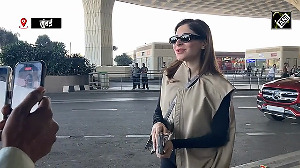Those who have worked long years with Rajiv Singh, vice chairman, DLF, India's largest realtor by market value, say he's unsentimental when it comes to business decisions about his family-owned group.
"He knows how to cut his losses and move on," said a colleague. If a project doesn't look scalable or capable of establishing a leadership position, he's happy to scrap it, he added. And that applies to projects Singh, a third-generation family businessman, has started as well.
For instance, in 1994, he was instrumental in setting up a 1.6 million tonne cement plant, thinking he saw synergies with DLF's core construction business and hoping to leverage a price advantage. By 2000, he realised that DLF Cement would not be among India's top five producers -- it wasn't DLF's core competence, after all -- so he sold it to Ambuja Cement.
The most recent example of his hard-nosed approach to the business he took over from his father is the 9.9 per cent stake in DLF that the Singh family sold on Wednesday to a clutch of foreign investors.
Money from the sale is intended to finance the debt obligations of DLF Asset Ltd, the wholly promoter-owned real estate investment trust ahead of a merger with the flagship.
Set up in 2007, DAL acquired DLF's four special economic zones that would have covered 19 million square feet when they were fully built-up and generated tax-free income.
In line with the REITs that were in vogue at the time, Singh hoped to list DAL on a global exchange. The confidence to do this stemmed from the fact that flagship DLF had listed on the Indian exchanges in mid-2007 to an enthusiastic response. DLF listed at Rs 582, an 11 per cent premium over the issue price.
DAL was not so lucky.
First, the plan ran into legal problems, mostly to do with the fact that there was no established legal system for listing REITs. Then, by the time regulatory approvals came through in January 2008, stock markets began to slide globally.
DAL was to be listed on the Singapore Stock Exchange in the first week of February, 2008. But the Indian stock market saw one of its worst falls on January 21 and 22, 2008. Everything went wrong after that.
Cancelling the listing created other problems.
D E Shaw, the hedge funds that had invested $400 million in DAL through optionally convertible preference shares in 2007 found its exit route closed once the listing was abandoned. With real estate values plummeting around the world, D E Shaw decided not to convert its shares and asked for its money back, the deadline for which was June this year.
By now, DAL's asset values had depreciated sharply. Faced with these problems, Singh said he could not hesitate to cannibalise DAL. The only question was to whether to buy out DE Shaw or infuse enough capital in DAL to repay other debts also.
"We decided to clean the books once and for all," he said.
This time, the luck that had deserted DAL seemed to have returned. The Singh family sold its shares at Rs 230 apiece, a slight discount over Tuesday's market price, though way off the peak of over Rs 1,200 in January, 2008 or the listing price of Rs 525. This brings the promoter-family's stake in DLF down to 78.5 per cent.
"Sometimes you have to take hard decisions because wealth is created through hard financial decisions rather than on notional values of market capitalisation," Singh said after the sale.
The Rs 3,860 crore (Rs 38.6 billion) that the family raised from Wednesday's sale will partly be used to pay off D E Shaw and partly to repay the Rs 4,900 crore (Rs 49 billion) DAL owes DLF.
Meanwhile, with little sign of a revival in real estate -- the sharp 93 per cent slide in DLF's fourth quarter earnings is testimony to this -- Singh is taking some more unsentimental decisions.
He's put DLF's Rs 1,400 crore (Rs 14 billion) wind power business on the block and is exiting real estate no-hope real estate projects around the country.
That leaves the question of DLF's diversification into financial services, notably insurance. Singh's still holding on to that, though analysts believe it needs cash to grow. And unless real estate revives and generates the cash, that's unlikely to happen.
The current prolonged downturn in real estate has been Singh's first major test as a businessman in his own right. The challenge must also leave less time for his one passion -- golf -- at which he's considered a decent hand.
The business this 59-year-old chemical engineer from Massachusetts Institutes of Technology took over from his father -- once India's fourth richest man -- was among India's most profitable.
With the DAL deal, he's acquitted himself a little, not least because, as some of his friends say, he's not been afraid to call a spade a spade. The question, of course, is whether he can build on this.







 © 2025
© 2025